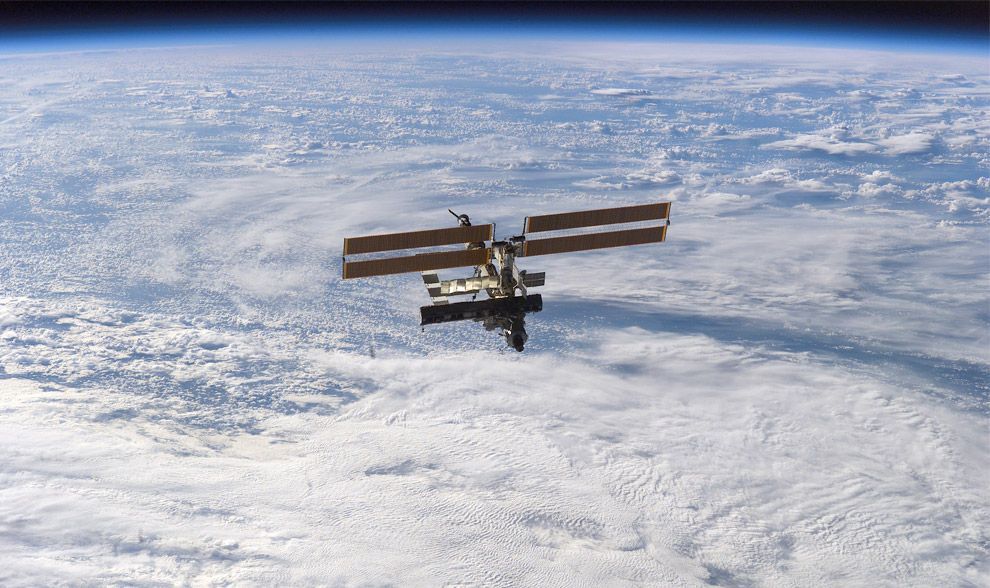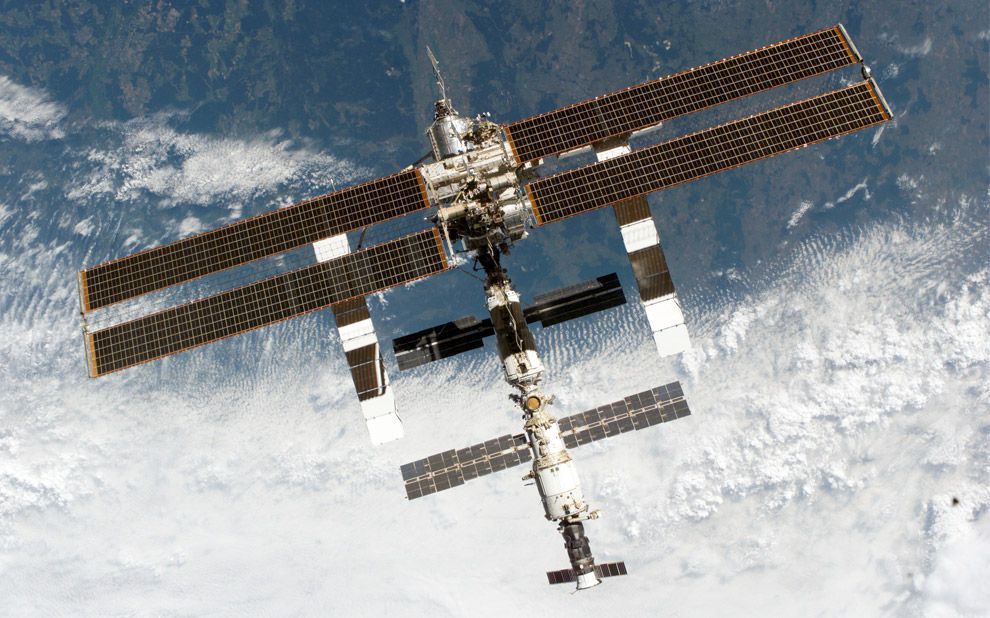Pardeep
๑۩۩๑┼●ℛŐŶ
$ .,.,. The International Space Station .,.,. $
This month marks the 10th anniversary of the first launched module of the International Space Station (ISS). The module Zarya was lifted into orbit on November 20th, 1998 by a Russian Proton rocket lifting off from Baikonur, Kazhakstan. In the decade since, 44 manned flights and 34 unmanned flights have carried further modules, solar arrays, support equipment, supplies and a total of 167 human beings from 15 countries to the ISS, and it still has a ways to go until it is done. Originally planned to be complete in 2003, the target date for completion is now 2011. Aside from time spent on construction, ISS crew members work on a good deal of research involving biology and physics in conditions of microgravity. If humans are ever to leave the Earth for extended periods, the ISS is designed to be the place where we will discover the best materials, procedures and safety measures to make it a reality.
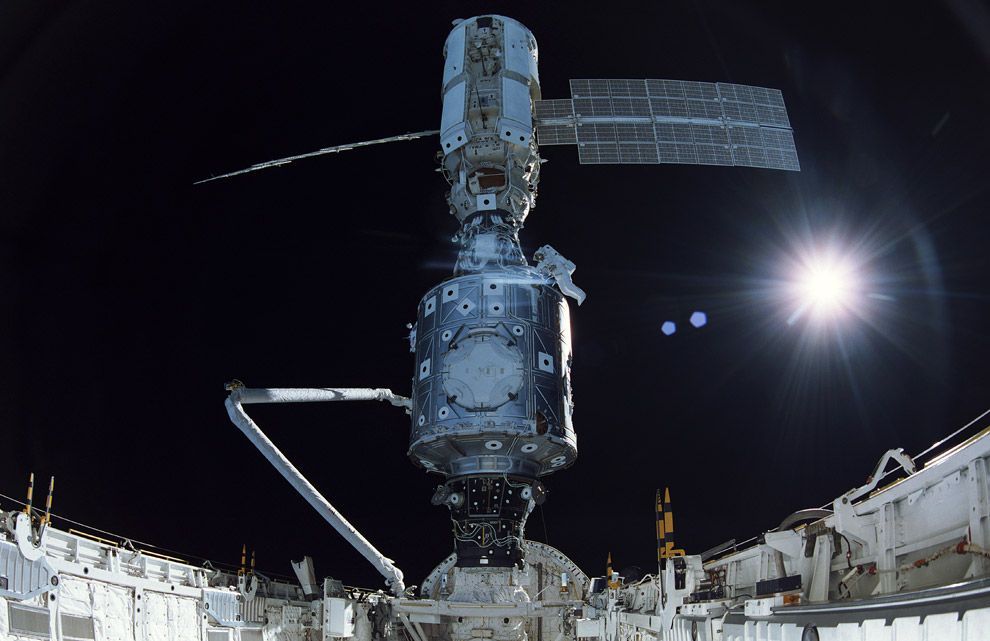
In December 1998, the crew of Space Shuttle Mission STS-88 began construction of the International Space Station - Astronaut James Newman is seen here making final connections the U.S.-built Unity node to the Russian-built Zarya module. The crew carried a large-format IMAX camera from which this picture was taken. (NASA)

Backdropped against a blanket of heavy cloud cover, the Russian-built FGB, also called Zarya, approaches the Space Shuttle Endeavour and the U.S.-built Node 1, also called Unity (foreground) on December 6th, 1998. Inside Endeavour's cabin, the STS-88 crew readied the remote manipulator system (RMS) for Zarya capture as they awaited the rendezvous. (NASA)
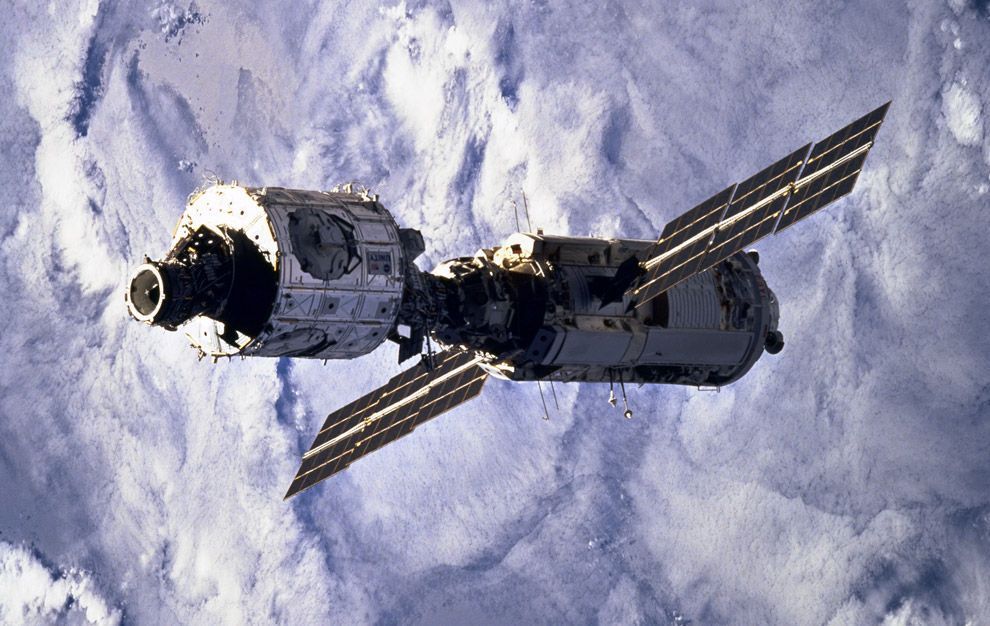
Blanketing clouds form the backdrop for this 70mm scene of the connected Zarya and Unity modules after having been released from Endeavour's cargo bay a bit earlier on December 4th, 1998. Six crew members, who had earlier spent the majority of their on-duty mission time working on the tandem of space hardware, watched the joined modules from Endeavour in a survey and fly-around mode. (NASA)

Astronaut Robert L. Curbeam, STS-98 mission specialist, was photographed by a member of the Expedition One crew in the newly installed Destiny laboratory during the second of three space walks on February 12th, 2001. Ahead of schedule, the astronauts connected several computer and electrical cables between the docking port and the lab; unveiled the lab's large, high-quality window (through which this photo was taken) and attached an exterior shutter; and repositioned a movable foot platform they had taken inside Atlantis on the first spacewalk for a slight adjustment. (NASA)

Space shuttle Endeavour is shown after rollback of the rotating service structure. The rollback was in preparation for liftoff on the STS-126 mission with a crew of seven. Above Endeavour's external tank is the vent hood, known as the "beanie cap," at the end of the gaseous oxygen vent arm, extending from the fixed service structure. Below is the orbiter access arm with the White Room at the end, flush against the shuttle. The rotating structure provides protected access to the shuttle for changeout and servicing of payloads at the pad. Photo taken Nov. 14, 2008. (NASA/Kim Shiflett)
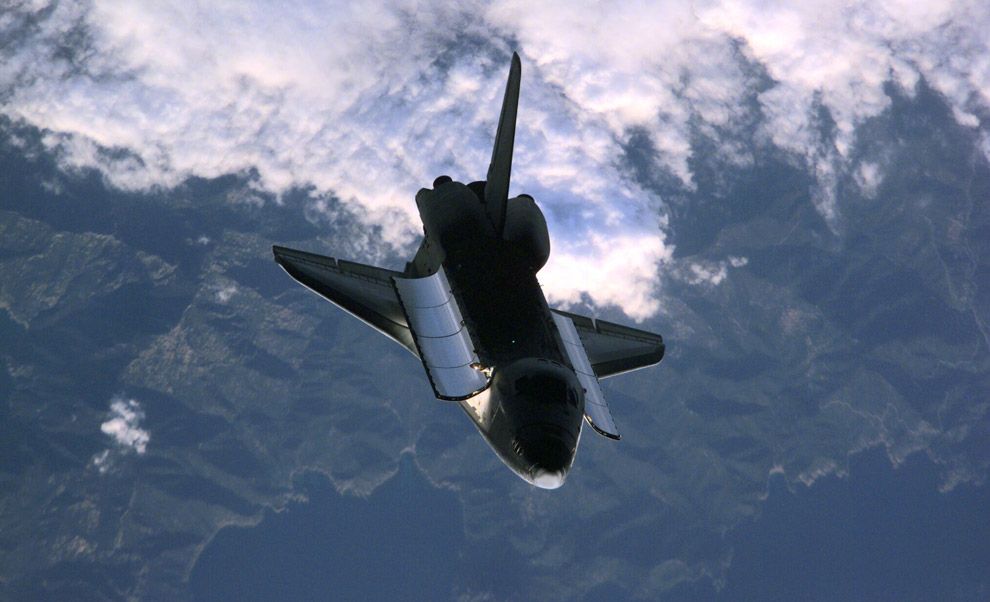
This high-angle image of the Space Shuttle Atlantis backdropped over a mountainous coastline was photographed on February 16th, 2001 by the three-man Expedition One crew aboard the International Space Station (ISS) shortly after the shuttle and the outpost unlinked following several days of joint operations of the two crews. The scene was recorded with a digital still camera. (NASA)

Cosmonaut Sergei K. Krikalev, Expedition One flight engineer, prepares to photograph some geographic targets of opportunity through a viewing port on the International Space Station's Zvezda Service Module in December of 2000. (NASA)
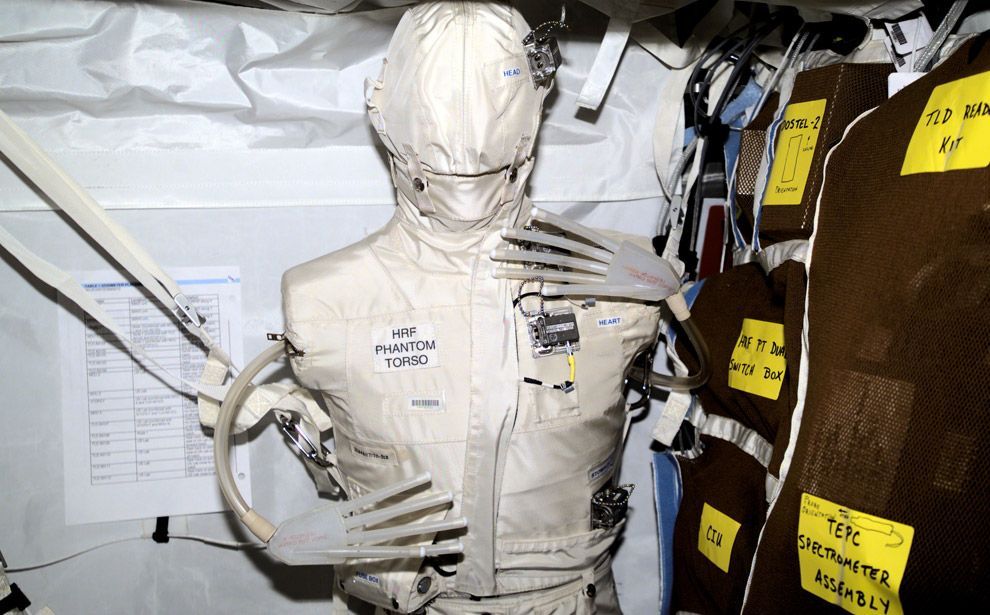
The Phantom Torso, seen here on May 13th, 2001 in the Destiny laboratory on the International Space Station (ISS), is designed to measure the effects of radiation on organs inside the body by using a torso that is similar to those used to train radiologists on Earth. The torso is equivalent in height and weight to an average adult male. It contains radiation detectors that will measure, in real-time, how much radiation the brain, thyroid, stomach, colon, and heart and lung area receive on a daily basis. The data will be used to determine how the body reacts to and shields its internal organs from radiation, which will be important for longer duration space flights. (NASA)

Silhouetted over Earth, the International Space Station (ISS) is seen on October 11th, 2000 in a configuration soon to be changed, once the approaching STS-92 crew adds its important new changes. If oriented with Earth's horizon on the left, the ISS elements, from the left, are Node 1 or Unity, the functional cargo block or Zarya, the service module or Zvezda and the Progress supply ship. In a matter of days, the crew went on to add the Z1 Truss structure and a third pressurized mating adapter. (NASA)

Astronaut Donald R. Pettit, Expedition 6 NASA ISS science officer, photographs his helmet visor during a session of extravehicular activity (EVA) on January 15th, 2003. Pettit's arms and camera are visible in the reflection of his helmet visor. Astronaut Kenneth D. Bowersox, mission commander, is also visible in visor reflection, upper right. (NASA)

The Expedition Three (white shirts), STS-105 (striped shirts), and Expedition Two (red shirts) crews assemble for a group photo in the Destiny laboratory on the International Space Station on August 17th, 2001. (NASA)

An overhead view of the exterior of the Space Shuttle Atlantis' crew cabin, part of its payload bay doors and docking system was provided by Expedition 16 crewmembers. Before docking with the International Space Station, astronaut Steve Frick, STS-122 commander, flew the shuttle through a roll pitch maneuver or basically a backflip to allow the space station crew a good view of Atlantis' heat shield. Using digital still cameras equipped with both 400 and 800 millimeter lenses, the ISS crewmembers took a number of photos of the shuttle's thermal protection system and sent them down to teams on the ground for analysis. Photo taken February 9th, 2008. (NASA)

Astronaut Carl E. Walz, Expedition Four flight engineer, catalogs canisters of water in the Zvezda Service Module on the International Space Station on March 11th, 2002. (NASA)
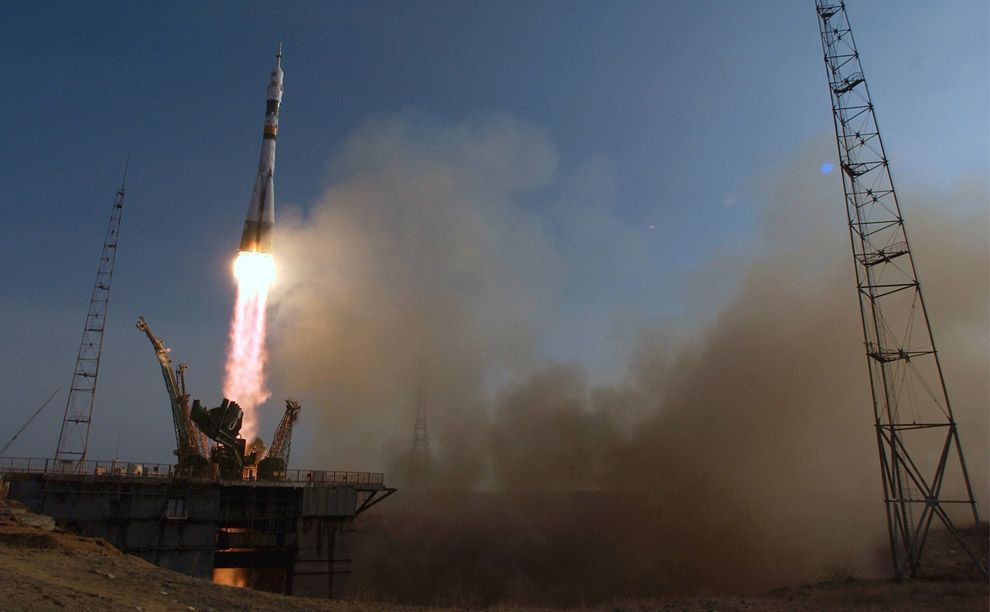
The Soyuz TMA-4 vehicle blasts off from the Baikonur Cosmodrome in Kazakhstan on April 19, 2004, carrying a crew of three to the ISS. (NASA/Bill Ingalls)

This month marks the 10th anniversary of the first launched module of the International Space Station (ISS). The module Zarya was lifted into orbit on November 20th, 1998 by a Russian Proton rocket lifting off from Baikonur, Kazhakstan. In the decade since, 44 manned flights and 34 unmanned flights have carried further modules, solar arrays, support equipment, supplies and a total of 167 human beings from 15 countries to the ISS, and it still has a ways to go until it is done. Originally planned to be complete in 2003, the target date for completion is now 2011. Aside from time spent on construction, ISS crew members work on a good deal of research involving biology and physics in conditions of microgravity. If humans are ever to leave the Earth for extended periods, the ISS is designed to be the place where we will discover the best materials, procedures and safety measures to make it a reality.

In December 1998, the crew of Space Shuttle Mission STS-88 began construction of the International Space Station - Astronaut James Newman is seen here making final connections the U.S.-built Unity node to the Russian-built Zarya module. The crew carried a large-format IMAX camera from which this picture was taken. (NASA)

Backdropped against a blanket of heavy cloud cover, the Russian-built FGB, also called Zarya, approaches the Space Shuttle Endeavour and the U.S.-built Node 1, also called Unity (foreground) on December 6th, 1998. Inside Endeavour's cabin, the STS-88 crew readied the remote manipulator system (RMS) for Zarya capture as they awaited the rendezvous. (NASA)

Blanketing clouds form the backdrop for this 70mm scene of the connected Zarya and Unity modules after having been released from Endeavour's cargo bay a bit earlier on December 4th, 1998. Six crew members, who had earlier spent the majority of their on-duty mission time working on the tandem of space hardware, watched the joined modules from Endeavour in a survey and fly-around mode. (NASA)

Astronaut Robert L. Curbeam, STS-98 mission specialist, was photographed by a member of the Expedition One crew in the newly installed Destiny laboratory during the second of three space walks on February 12th, 2001. Ahead of schedule, the astronauts connected several computer and electrical cables between the docking port and the lab; unveiled the lab's large, high-quality window (through which this photo was taken) and attached an exterior shutter; and repositioned a movable foot platform they had taken inside Atlantis on the first spacewalk for a slight adjustment. (NASA)

Space shuttle Endeavour is shown after rollback of the rotating service structure. The rollback was in preparation for liftoff on the STS-126 mission with a crew of seven. Above Endeavour's external tank is the vent hood, known as the "beanie cap," at the end of the gaseous oxygen vent arm, extending from the fixed service structure. Below is the orbiter access arm with the White Room at the end, flush against the shuttle. The rotating structure provides protected access to the shuttle for changeout and servicing of payloads at the pad. Photo taken Nov. 14, 2008. (NASA/Kim Shiflett)

This high-angle image of the Space Shuttle Atlantis backdropped over a mountainous coastline was photographed on February 16th, 2001 by the three-man Expedition One crew aboard the International Space Station (ISS) shortly after the shuttle and the outpost unlinked following several days of joint operations of the two crews. The scene was recorded with a digital still camera. (NASA)

Cosmonaut Sergei K. Krikalev, Expedition One flight engineer, prepares to photograph some geographic targets of opportunity through a viewing port on the International Space Station's Zvezda Service Module in December of 2000. (NASA)

The Phantom Torso, seen here on May 13th, 2001 in the Destiny laboratory on the International Space Station (ISS), is designed to measure the effects of radiation on organs inside the body by using a torso that is similar to those used to train radiologists on Earth. The torso is equivalent in height and weight to an average adult male. It contains radiation detectors that will measure, in real-time, how much radiation the brain, thyroid, stomach, colon, and heart and lung area receive on a daily basis. The data will be used to determine how the body reacts to and shields its internal organs from radiation, which will be important for longer duration space flights. (NASA)

Silhouetted over Earth, the International Space Station (ISS) is seen on October 11th, 2000 in a configuration soon to be changed, once the approaching STS-92 crew adds its important new changes. If oriented with Earth's horizon on the left, the ISS elements, from the left, are Node 1 or Unity, the functional cargo block or Zarya, the service module or Zvezda and the Progress supply ship. In a matter of days, the crew went on to add the Z1 Truss structure and a third pressurized mating adapter. (NASA)

Astronaut Donald R. Pettit, Expedition 6 NASA ISS science officer, photographs his helmet visor during a session of extravehicular activity (EVA) on January 15th, 2003. Pettit's arms and camera are visible in the reflection of his helmet visor. Astronaut Kenneth D. Bowersox, mission commander, is also visible in visor reflection, upper right. (NASA)

The Expedition Three (white shirts), STS-105 (striped shirts), and Expedition Two (red shirts) crews assemble for a group photo in the Destiny laboratory on the International Space Station on August 17th, 2001. (NASA)

An overhead view of the exterior of the Space Shuttle Atlantis' crew cabin, part of its payload bay doors and docking system was provided by Expedition 16 crewmembers. Before docking with the International Space Station, astronaut Steve Frick, STS-122 commander, flew the shuttle through a roll pitch maneuver or basically a backflip to allow the space station crew a good view of Atlantis' heat shield. Using digital still cameras equipped with both 400 and 800 millimeter lenses, the ISS crewmembers took a number of photos of the shuttle's thermal protection system and sent them down to teams on the ground for analysis. Photo taken February 9th, 2008. (NASA)

Astronaut Carl E. Walz, Expedition Four flight engineer, catalogs canisters of water in the Zvezda Service Module on the International Space Station on March 11th, 2002. (NASA)

The Soyuz TMA-4 vehicle blasts off from the Baikonur Cosmodrome in Kazakhstan on April 19, 2004, carrying a crew of three to the ISS. (NASA/Bill Ingalls)







